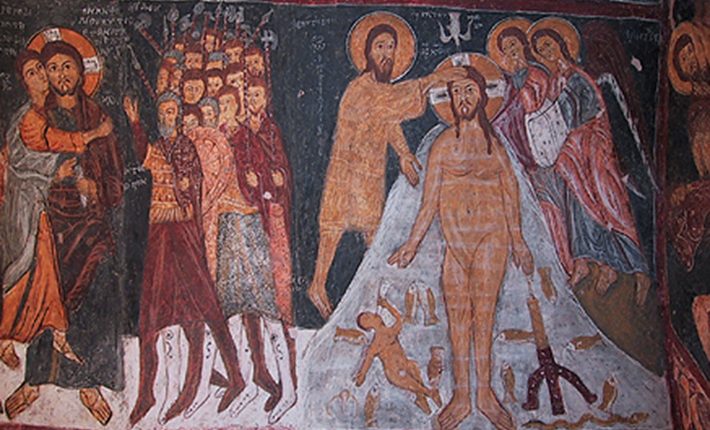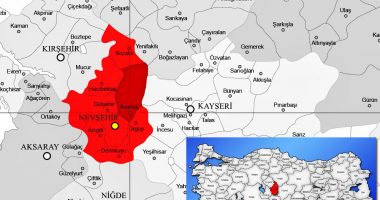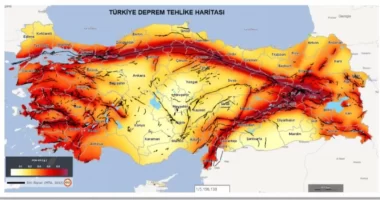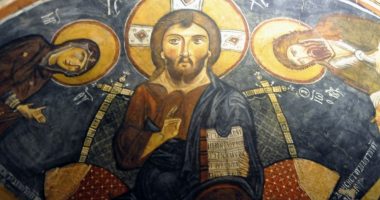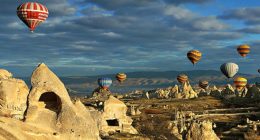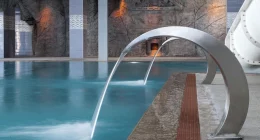Table of Contents
St. Jean’s Church, colloquially known as the “Opposite Church”, is located in the Gülşehir district of Nevşehir. St. Jean’s Church was carved into a fairy chimney located on the edge of the settlement area of Gülşehir district of Nevşehir province. It can be easily understood from the surrounding fairy chimney and the places carved into the tuff rock that the area where St. Jean’s Church is located was a dense settlement during the Byzantine period. There are two more rock-cut churches in the immediate vicinity of the church, but these churches do not have frescoes.
St. Jean’s Church was carved into a fairy chimney as two floors. The church on the lower floor has a single apse, a cross plan and the cross arms are barrel vaulted. It is older than the church on the upper floor, and stylized animal and geometric cross motifs are depicted with red ocher on the bedrock on the walls.
The upper church was accessed from the lower church by stairs carved into the rock. Since the original rock-hewn stairs were demolished, a regular iron staircase was built to provide access to the upper church during the renovation.
St. Jean’s Church on the upper floor has a single apse and a single nave. There are two niches on the north and south of the main apse, three on the west wall, and two on the north wall. According to the inscription found on St. Jean’s Church apse, it is dated to April 25, 1212.
You may be interested: Cappadocia Hot Air Balloon Tour Price
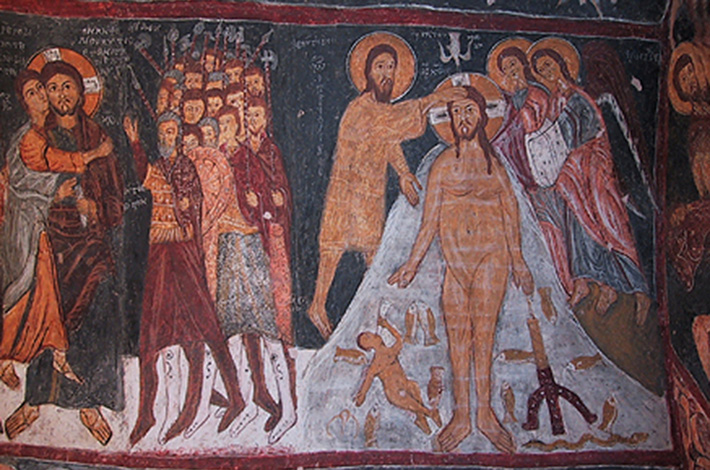
Causes of Deterioration of St Jean’s Church
As a result of the research carried out in St. Jean’s Church, it was understood that various factors caused the deterioration of the church. These;
– Covering the paintings with soot from oil lamps used for lighting purposes with a black soot layer,
– Destruction of the paintings by water leaking from cracks and holes in the rock block as a result of the examination caused by erosion,
– The sun rays entering through the window cause the pictures to fade, the plaster layer to flake and the paint to become dusty,
– It was determined that the scratches and scrapings made by people on the walls also caused the destruction of the paintings.
The causes of deterioration revealed by the researches were tried to be eliminated by the renovation and conservation studies. The renovation of St. Jean’s Church started in 1995, and the renovation ended in 1996. The expenses were met from the revenues of the ruins.
St. Jean’s Church, colloquially known as the “Opposite Church”, is located in the Gülşehir district of Nevşehir. St. Jean’s Church was carved into a fairy chimney located on the edge of the settlement area of Gülşehir district of Nevşehir province.
Restoration and Conservation Studies
Soot, ammonium bicarbonate E.D.T.A and carboxymethyl cellulose covering the surfaces of the paintings were mixed in the required proportions and applied to the sooty surface. The process was continued until the soot softened, and the pictures were cleaned from the soot by repeating 2-3 times according to the thickness of the soot.
Illustrated Scenes in St. Jean’s Church
The scenes in St. Jean’s Church are friezes bounded by red bands. Yellow, brown and white colors were used on a black background in painting. The ground color in the area where the prophets are depicted in medallions, located in the middle of the vault, is darker than the other parts. Niche vaults and other spaces are decorated with vegetal and geometric motifs. St. Jean’s Church was painted with the Tempera (sekko) painting technique, as is the case with the Cappadocia churches. In this technique, unlike the fresco technique, painting is done on dry plaster.
Apse
The scene cannot be selected due to dampness and destruction. However, in most of the Cappadocia-painted rock churches, there is a Deesis (prayer) scene in the apse. Here, too, this scene should probably have been processed. There are portraits of two saints in two niches to the south of the apse. One of the niches in the north has been destroyed. In the other niche, there is a portrait of the Saint.
West Wall
Above is the scene of St George and St Theodor killing the snake, and below are the scenes of the apocalypse and hell.
North Wall
It has been partially destroyed. There is the descent of Jesus from the cross, the women at the empty tomb, the descent of Jesus into Hell (Anastasis), and a paradise scene, which is also partially destroyed and is rare in the region. Here, naked in palm trees, there is the scene of Jesus holding leaves next to Mary and Abraham’s lap scene.
South Wall
The last meal, the betrayal of Judas, the Baptism scene, the death of Mary (Koimesis) and the burning of three Hebrew youths in the oven are located just below.
There are portraits of Constantine and Helena in one of the three niches below them, and portraits of religious martyrs from the other two niches.
There are symbolic patterns on the first floor. Both the lower and upper floors have a barrel vaulted ceiling. There is also a parsonage and wine cellar section on the lower floor.
St. Jean’s Church has a single apse; To the left and right of the apse, there are two chambers for communion, each with a single column and small dome, resembling a baldachin design. Their columns are damaged. Here the saints can be seen standing standing with a model of the church in their hands, of which I could only read the name Panteleimon on the right side of the entrance, the others were not engraved but the destruction of time has rendered them somewhat illegible.
Other Parts of St. Jean’s Church
Michael and Gabriel in the apse vault; On the front surface of the apse, pictures of a saint are seen on the left and the saint on the right. Especially in the apse section, the symmetrical order and originality are very evident both in the illustrations and in the architecture. Here is the Annunciation scene, an example of which can be found in Gümüşler. When we turn our face to the apse, Gabriel and a dove are on the upper left; a dove and Meryem are seen in the upper right. The passage of the Holy Spirit, whose symbol was the Dove, from Gabriel to Mary at the moment Gabriel gave the gospel, could not be better described than this.
The painting program on the ceiling does not comply with the cyclical narrative order, there is no specific order. The pictures on the medallions, starting from the apse, belong to the following prophets, in order: David, Solomon, Elijah, Noah, Jeremiah and Manasis.
On the left wall (north wall) of the entrance is a beautifully drawn white horse. Although the picture of his rider was destroyed, it can be thought of as St. Yorgos. To its right is a saint whose face has been destroyed, but the script of St. Artemis can be read, and to the far right is an engraved donor picture. The inscription argirios (ie donors, donors) stands out here. In the upper right and left corners of the painting, it is seen that God is symbolized with the sign of the ayia triad (holy trinity).
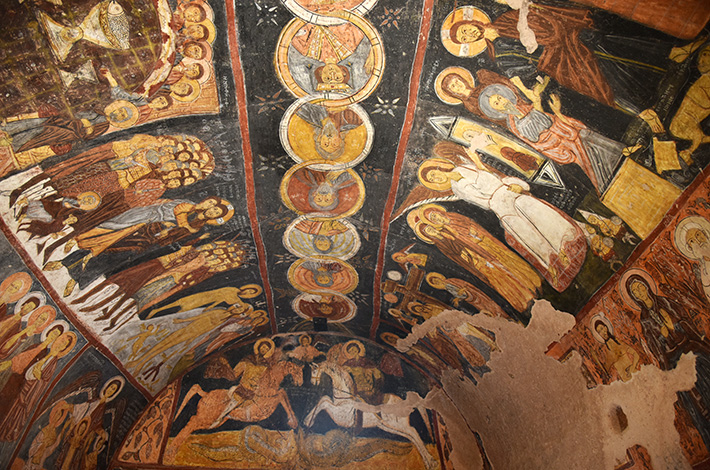
On the right wall of the entrance, there is a large picture of Constantine and Helena. The cross between the two figures is the Constantine-Helena cross. (I think it could also be called a real cross.) In a window-shaped niche on the right are the pictures of St. Prokopios and St. Dimitrios.
The most characteristic figures of St. Jean’s Church can be seen on the wall of the narthex behind the staircase compared to the entrance. These paintings bring to mind Ihlara Yılanlı in terms of the subject. At the top, two equestrian saints are placed to the right and left of an angel. Below this is the window of St. Jean’s Church. On the left of the window, the scene of hell (or apocalypse) can be seen, where demons riding on dragons and souls being punished are depicted.
Note: Click for German dream interpretations
To the right of the window is the scene of the weighing of souls. Below the window, on the left, there is a donor whose name is read in the middle, and her children, next to her is a saint whose name cannot be read. In fact, it can be understood from this picture that St. Jean’s Church was built in the name of this saint and that its name is not the Church of John the Baptist. Because in that era, the saints the churches were dedicated to were written next to the donor pictures. There is a similar situation here.
Also, the baptism scene in St. Jean’s Church is very impressive; It is considered interesting, especially since the human faces reveal the characteristics of the region. To the right of this picture is the picture of Paraskevi, which has been destroyed but can be read as Paraskevi, and to the far right is the picture of Azize Kiryaki.
